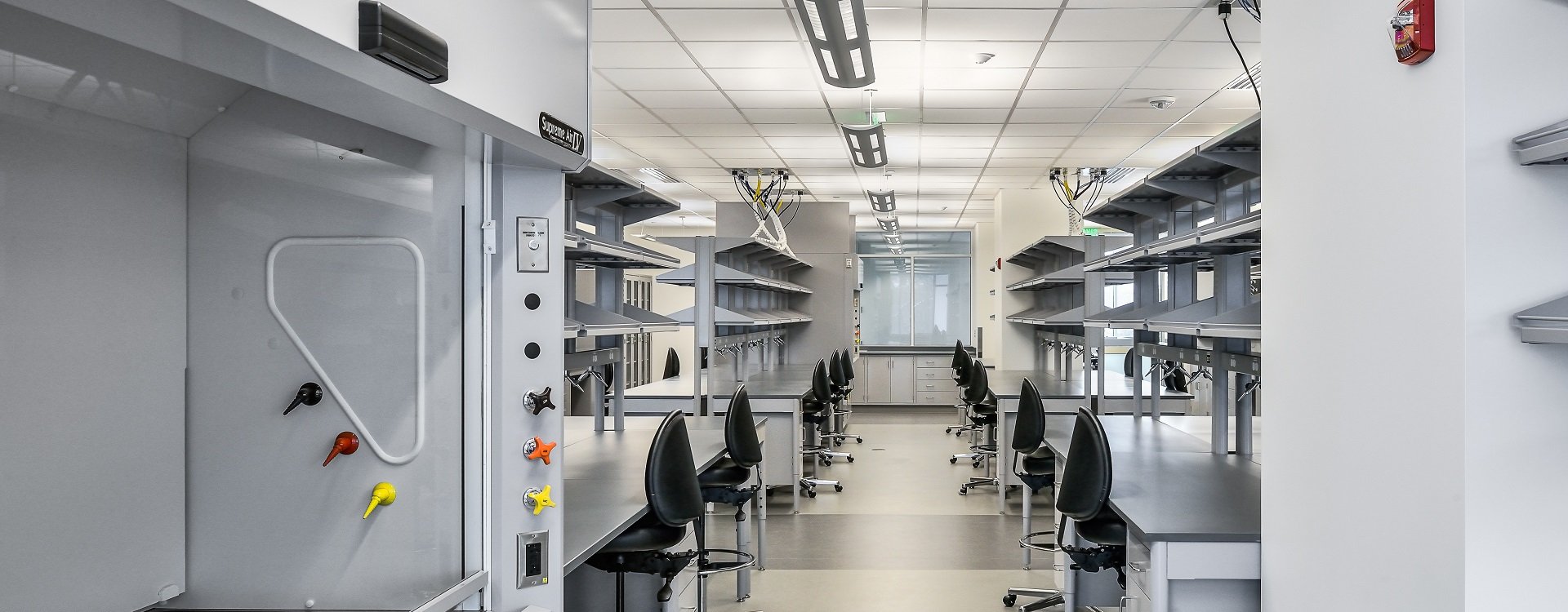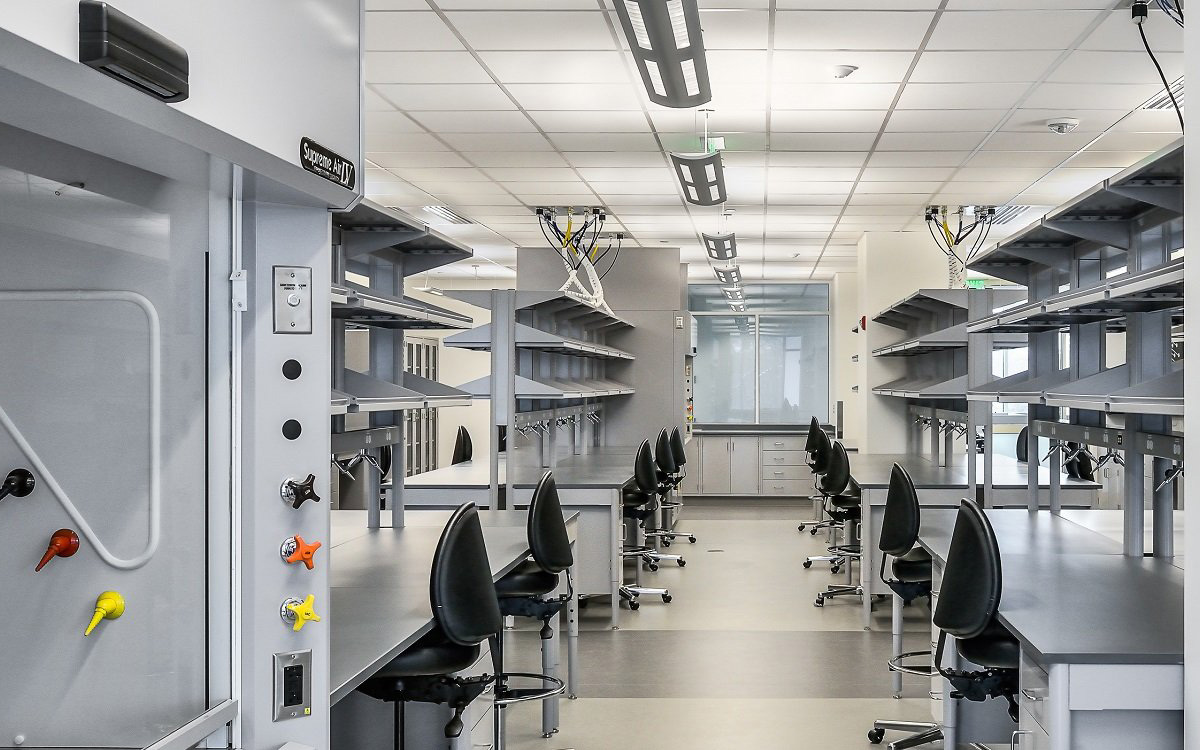Comparison Between ASHRAE 110 and EN14175 Test Standards
Date: 2022-01-17 Source: RUANQI Classification: Resources
Comparison and analysis of test methods for exhaust fume hood in laboratory
Comparative analysis of EN 14175, ANSI / ASHRAE 110 and JB / T 6412-1999
Li Siwei, Liu Dong, School of mechanical engineering, Tongji University
Abstract
In this paper, the test methods of exhaust fume hood in European standard (EN 14175), American Standard (ASHRAE 110) and Chinese standard (JB / T 6412-1999) are compared, and the differences of basic test conditions, surface wind speed test methods and pollutant concentration test methods in each standard are analyzed in detail, After comprehensive comparison, it is concluded that the test method in ASHRAE 110 has high comprehensive evaluation.
Introduction
Exhaust hood is an important equipment for controlling pollutants in laboratory. At present, in order to ensure the safety and health of laboratory personnel, the requirements for Laboratory environmental control are higher and higher, and people pay more and more attention to the efficiency and safety of exhaust fume hood, and formulate corresponding exhaust fume hood standards. For example, the United States formulated ANSI / ASHRAE 110-1995 [1] in 1995, revised it [2] in 2003, and published BSR / ASHRAE 110; Europe formulated the European standard EN 14175 [3] in 2003; China also formulated the relevant standard JB / T 6412-1999 in 1999 to guide and standardize the production and use of exhaust cabinets in China [4].
This paper will compare the detection methods of exhaust fume hood mentioned in en 14175, ANSI / ASHRAE 110-1995 (including some amendments in BSR / ASHRAE 110p, hereinafter referred to as ASHRAE 110) and JB / T 6412-1999.
Main test items
The air distribution in the exhaust cabinet must be reasonable, so as to control the pollutants emitted in the cabinet and enable them to be smoothly discharged outdoors, rather than escaping indoors through the operation port of the exhaust cabinet, endangering the health and safety of the experimental personnel. In order to evaluate this performance of the exhaust hood, although there are differences in the standard rules formulated by various countries, they all have two same basic elements, namely, surface wind speed and pollutant control concentration.
ANSI / AIHA Z9 was formulated by American National Standards Institute (ANSI) and American Industrial Hygiene Association (AIHA) in 1992 5-1992 laboratory ventilation standard emphasizes that surface wind speed is an important index to evaluate the performance of exhaust fume hood. The so-called surface wind speed is the control wind speed on the operation surface of the exhaust cabinet. Generally, the surface wind speed shall be controlled within the range of 0.4 ~ 0.6m/s. The surface wind speed is too small, indicating that the control effect of the exhaust fan on the operating surface is not enough, and the pollutants in the cabinet are easy to get rid of the predetermined air flow discharge path and escape out of the exhaust cabinet through the operating surface; The surface wind speed is too high, which is easy to produce turbulence in the area near the outlet in the cabinet, affecting the air distribution form of the exhaust cabinet, and pollutants may accumulate in the corner of the exhaust cabinet or escape from the operation surface [5, 6]. The ideal surface wind speed test results should make the surface wind speed within the predetermined range and the wind speed distribution on the operating surface as uniform as possible.
However, the research shows that even when the surface wind speed meets the requirements, the control of pollutants by the exhaust hood may not be able to achieve the expected goal. From 176 exhaust cabinet test reports conducted according to ashrae110, it is found that the correlation coefficient between the exhaust cabinet surface wind speed and the control concentration of tracer gas is only 0.24 [7]. Therefore, in 1995, ANSI / ASHRAE 110-1995 laboratory exhaust cabinet performance test method introduced by ANSI and American Society of heating, refrigeration and Air Conditioning Engineers (ASHRAE) not only adheres to the test of surface wind speed, but also first puts forward another index to evaluate the performance of exhaust cabinet: pollutant concentration test. At present, most countries have listed pollutant test as another very important evaluation index in exhaust hood test. The pollutant control concentration refers to the tracer gas concentration on the operation surface when the exhaust cabinet is in normal operation and the tracer gas is released at the speed of 2 L / min in the cabinet. In ASHRAE 110 and JB / T 6412-1999, the tracer gas concentration at the breathing belt of the dummy in front of the cabinet is used as the control concentration, and the release rate of the tracer gas in the cabinet is 4 L / min; In en 14175, the tracer gas concentration on the operating surface is used as the control concentration. At this time, the release rate of tracer gas in the cabinet is 2 L / min. Compared with the surface wind speed, the pollutant control concentration can more directly reflect the pollutant control effect of the exhaust cabinet. However, there are many chemicals in nature, and the pollutant control concentration only reflects the control of the exhaust hood on the chemicals with similar chemical and physical properties to the selected tracer gas. Therefore, the index of pollutant control concentration can not fully reflect the performance of the exhaust hood. Therefore, at present, national standards mainly use surface wind speed and pollutant control concentration to evaluate the performance of exhaust fume hood, and add some other evaluation indexes according to their own national conditions.
Overview of national standards
2.1 American Standard (ASHRAE 110 method of testing performance of laboratory fume hood)
ASHRAE 110 is the most widely applicable exhaust hood standard in the world. Its purpose is to provide quantitative and qualitative test methods to evaluate the control ability of laboratory exhaust hood to pollutants. The quantitative test method is the surface wind speed test and pollutant control concentration test described above, while the qualitative method is the flow display test.
The flow display test is to directly display the flow mode of air flow in the exhaust cabinet by using visual flue gas. In ASHRAE 110, the flow display test is divided into two types: Micro flue gas test and large flue gas test. This qualitative test method has the advantages of simple operation and intuitive results, but it also has its limitations. First, strong subjectivity. Although ASHRAE 110 is constantly strengthening the standardization of the description of its test results, for example, the latest BSR / ASHRAE 110p (i.e. the revised version of ANSI / ASHRAE 110-1995) not only increases the content of flow display test, but also standardizes the description of its test results, the description still has considerable subjectivity and its reliability is reduced. Second, the results cannot be quantified. No further comparison can be made between two results with the same description. Finally, the scope of human eye observation is limited, and its small change or escape can not be distinguished. In view of the above limitations, the flow display test is always only an auxiliary test, but can not become a necessary evaluation index.
2.2 Chinese standard (JB / T 6412-1999 exhaust hood)
JB / T 6412-1999 specifies the type, basic parameters and dimensions, technical requirements, test methods and inspection rules, as well as marking, packaging and storage of exhaust cabinets. In addition to the test content of ASHRAE 110, the test method also adds a resistance test. The purpose of resistance test is to measure the resistance of exhaust cabinet. This index can indirectly reflect whether the design of exhaust cabinet is reasonable and whether the air flow is smooth from another side.
The measurement principle is to use pitot tube to measure the total pressure value and dynamic pressure value in the exhaust pipe, then calculate the wind speed in the pipe from the dynamic pressure value, and then calculate the local resistance of each joint and the resistance along the pipeline according to the wind speed. After the dynamic pressure, local resistance and resistance along the way are subtracted from the total pressure value measured at the beginning, the remaining is the resistance of the exhaust cabinet.
2.3 European standard (EN 14175 fume cupboards)
The description of EN 14175 is the most detailed among all the current exhaust cabinet standards, with a total of 6 parts, namely: terminology, safety specifications and operation requirements, specification test methods, field test methods, installation and maintenance suggestions and variable air volume exhaust cabinet. The standard test method describes in detail the test method for exhaust cabinet detection in the detection room, which is divided into five parts: air flow test, sliding door test, air flow indicator test, structure and material test and lighting test. Compared with ASHRAE 110, the air flow test omits the flow display test and increases the anti-interference test Ventilation efficiency test, differential pressure test and other related contents are designed to reflect the performance of exhaust cabinet more accurately and comprehensively by quantitative method.
The purpose of anti-interference test is to investigate whether the pollutant control ability of exhaust cabinet will be affected if operators walk in front of the cabinet. During the test, a flat plate moves back and forth to simulate the possible impact on the operation of the exhaust cabinet when the operator operates in front of the cabinet, and then record the change of tracer gas concentration on the operating surface during the movement.
The purpose of ventilation efficiency test is to investigate the time required for the exhaust cabinet to completely discharge the pollutants in the cabinet under the condition of normal ventilation in the laboratory, that is, the attenuation of pollution concentration inside and outside the cabinet when there are no pollutants in the cabinet.
Differential pressure test is to measure the gauge pressure in the exhaust pipe with a micro manometer to see whether it meets the predetermined differential pressure.
Comparison and analysis of test methods
Although some test items are the same, such as surface wind speed test and pollutant control concentration test, the test requirements specified in each standard are also different. The following compares and evaluates each test method.
3.1 Basic test conditions
The preparation before the test determines the reliability and accuracy of the test to some extent. In the three standards mentioned above, corresponding requirements are made for basic test conditions. See Table 1 for details.
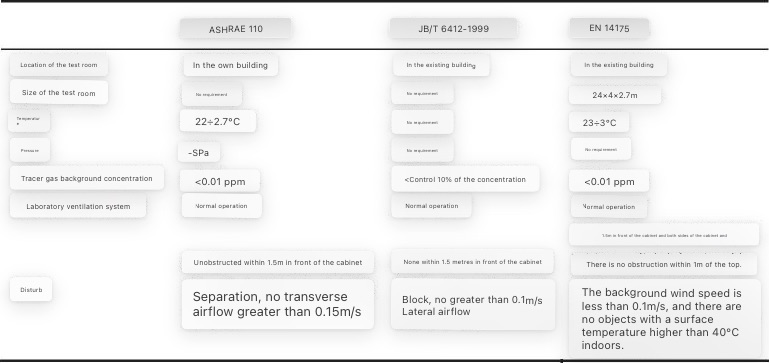
Table 1 Comparison of basic test conditions
It can be seen from table 1 that the differences in this part mainly focus on the size of the test chamber, temperature, pressure, background concentration of tracer gas and requirements for avoiding interference. In the test of exhaust hood, the size of test room will mainly affect the test results of pollutant concentration and the air distribution form on the operating surface. The small size of the test room has two effects. First, the air supply outlet of the laboratory ventilation system will be too close to the operating surface of the exhaust cabinet, and its air supply flow speed is too large to meet the basic test conditions mentioned above, which will affect the control of pollutants by the exhaust cabinet [5]; Second, because the amount of tracer gas is certain, the too small size of the test room means that the concentration of tracer gas in the room will be too large to meet the final requirements of the test. On the contrary, if the size of the test room is too large, the concentration measurement results will be too small, forming an illusion that the exhaust cabinet is very effective in controlling pollutants.
In terms of temperature, ASHRAE 110 is converted according to 72 ± 5 ° F, which is almost consistent with the requirements of EN 14175. Theoretically, the test can be carried out at room temperature, but the test results will be different under different indoor temperatures. In order to make the test results of different exhaust cabinets comparable and repeatable, it is generally believed that the temperature of the test room should be controlled.
The space pressure of the chemical laboratory shall ensure a certain negative pressure difference relative to the adjacent areas to prevent the diffusion of indoor pollutants. Therefore, the pressure control requirements proposed by ASHRAE 110 are very necessary. ASHRAE 110 and en 14175 have the same requirements for the background concentration of tracer gas, but the requirements of JB / T 6412-1999 are relatively lower (the upper limit of concentration specified in JB / T 6412-1999 is 0.5ppm), and the background concentration of the test can be determined whether it is effective or not only after the test is completed and compared with the final test results.
Among the requirements for avoiding interference, the requirements of the three standards are basically the same. It is generally recommended that the room air supply speed in the area 1.5m in front of the exhaust cabinet should not exceed 20% of the surface wind speed of the exhaust cabinet [8]. Therefore, the air supply speed in the area should be reduced as much as possible to avoid strong fluctuation of surface wind speed and local eddy current, resulting in the escape of pollutants. It is worth mentioning that en 14175 specifically points out that there can be no high-temperature objects in the test room, so as to avoid the impact of hot pressure on air distribution.
Therefore, in this respect, the requirements mentioned in en 14175 are more detailed and comprehensive.
3.2 surface wind speed test
As the earliest evaluation index, the surface wind speed has been recognized by all countries, and the test process is roughly the same. The differences between the standards are mainly reflected in the selection of measuring instruments, the layout of measuring points and data processing, as shown in Table 2.
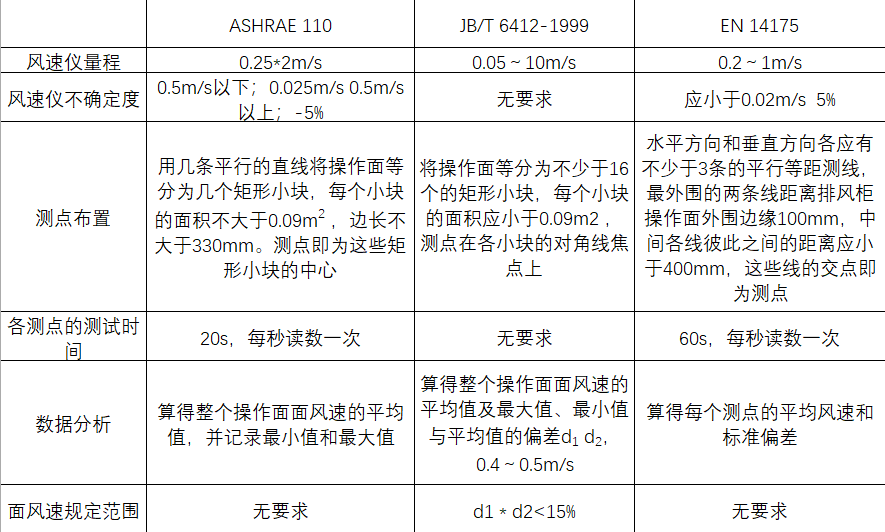
Table 2
It can be seen from table 2 that the requirements for the layout of measuring points and data processing in various standards are basically similar, but JB / T 6412-1999 specifies that the number of measuring points is not less than 16, which is also to ensure that the test results are reliable enough to reflect the wind speed distribution on the whole operation surface to a certain extent. In this part, the main difference between the standards lies in the selection of anemometer and the number of data records at each measuring point.
As for the selection of anemometer, it can be calculated directly from the data in the table. According to ASHRAE 110, the minimum error of the selected anemometer is:
0.025m/s, the maximum error is 0.1m/s; According to en 14175, the minimum error of the selected anemometer is 0.03m/s and the maximum error is 0.07m/s. The specified range of surface wind speed of exhaust cabinet is 0.4 ~ 0.6m/s. Within this range, the error range of anemometer selected according to en 14175 is 0.04 ~ 0.05m/s, which is slightly larger than the error range of anemometer selected according to ASHRAE 110 of 0.025 ~ 0.03m/s. In addition, if the design is unreasonable, the surface wind speed of the exhaust cabinet may exceed 1m / s. therefore, the provisions on the range of anemometer in ASHRAE 110 should be more reasonable.
ASHRAE 110 of the 1995 edition stipulates that the number of readings at each measuring point is 4 times, while in 110p, it not only increases the number of readings and specifies the reading time, but also emphasizes that the anemometer must be fixed with a bracket during the test process and cannot be held by hand. The purpose of this is to increase the reliability and accuracy of the test. For a single measuring point, 20 and 60 readings can ensure the accuracy of the test results. Therefore, on this premise, reading 60 times not only unnecessarily prolongs the test time, but also increases the workload of data processing, which has little impact on the final test results.
3.3 Pollutant Testing
The test of the tracer gas concentration is the focus of each standard, and it is also where the difference is greatest. The tracer gas test part of JB/T 6412-1999 is quoted from ASHRAE 110, but only the most basic test items are retained, so this part of JB/T 6412-1999 is not covered separately in the following description. Table 3 compares the basic concentration test in ASHRAE 110 with the inner plane test in EN14175. (The so-called internal test plane refers to the operating plane of the exhaust cabinet, that is, a plane with the horizontal edge on both sides of the opening of the door and the vertical edge on the inner wall of the exhaust cabinet.)
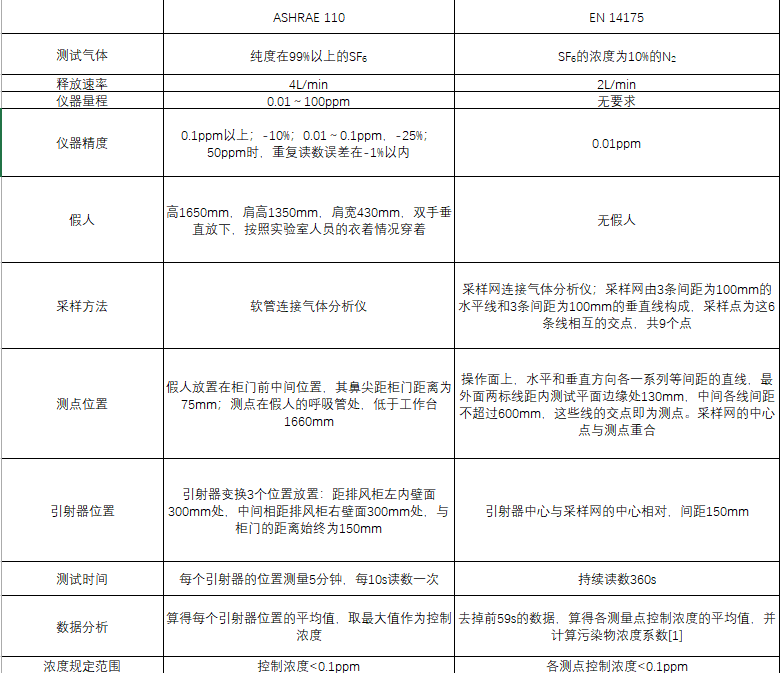
Table 3
As can be seen from the comparison in Table 3, ASHRAE 110 and EN14175 adopt two completely different methods for testing pollutant concentration. Comparing the two methods from three aspects of economy, credibility and operability, it is found that the test method in ASHRAE 110 is more reasonable.
First of all, SF6 is a relatively expensive gas from the economic point of view, the reason why EN 14175 uses N2 with 10% SF6 concentration as a test gas is to reduce the test cost. However, the lower SF6 concentration means that the detection limit and accuracy of the gas analyzer need to be improved, which means that the total test cost may still increase. Secondly, it is mentioned in EN 14175 that the accuracy of the gas analyzer is 0.01ppm, and the specified test point control concentration should be less than 0.01ppm, which means that when the tracer gas concentration of the test point is less than 0.01ppm, the gas analyzer can not measure the specific value. Even if the gas concentration at the test point is 0.0099ppm. When the column of the test point control concentration in the test report indicates the words "<0.01ppm", the actual control concentration may be much less than 0.01ppm, or it may be very close to 0.01ppm, but it can not be measured due to the problem of the test instrument and method, so the credibility of the report is discounted. Finally, from the operational level, to detect the tracer gas with a concentration of 0.01ppm, the standard gas concentration used for comparison should be 0.005 or 0.001ppm, whether it is prepared by oneself or directly purchased, the concentration error of the standard gas is relatively large, and the preparation is extremely inconvenient. Taking these three aspects into consideration, the practice of EN 14175 hoping to test with low concentration of SF6 at a lower occurrence rate to reduce the cost is questionable. In ASHRAE 110-1995, there is no mandatory requirement to use 100% purity SF6, but in the 110P version, this restriction is mentioned, requiring that SF6 must be used with a purity of more than 99%.
Another big debate is whether dummies should be used in tests. The European Standards Committee's explanation for not using dummies is that there are differences in body size, and no one dummy can represent all of them. However, in fact, the purpose of placing the dummy is not to completely simulate the situation where there are experimental personnel operating in front of the cabinet, but to reproduce the situation where eddy currents are formed in some areas in front of the cabinet when someone is operating in front of the cabinet because of the obstruction of the personnel, and the control concentration at this time can better reflect the performance of the exhaust cabinet. Also, regarding the size of the dummy, each country has a standard mannequin based on the results of the survey of the height and size of its people, and although this model does not represent the size of all people, it is enough to reflect the standard size of a country's people.
In addition to the basic test, there are two sets of tests in ASHRAE 110 to make up for the deficiencies in the basic test: (1) Remove the dummy, move the sampling probe around the edge of the exhaust cabinet door at an equal speed, and record the maximum concentration and position in this process. ② Put the dummy back in place, open the ejector and close the door. After two minutes, the background concentration in the room is tested. Then slowly open the door at constant speed, record the SF6 concentration in this process, and take the maximum value. After the operation is stable, the door is slowly closed at the same speed, and the SF6 concentration is continuously recorded. As can be seen, the procedure is similar to the test method of EN 14175 and is faster and more convenient. The procedure is similar to the external test plane test in EN 14175.
Conclusion
This paper comprehensively describes and compares the relevant standards for the performance test of exhaust cabinets in Europe, the United States and China. Although the expression of each standard is different, the basic items of the test and the main control indicators are consistent, that is, the two main indicators of surface wind speed and control concentration. Among them, after analysis, the comparison results between the standards can be expressed in Table 4.

Table 4
It can be found from Table 4 that ASHRAE 110, as the most common test method at present, has the best test completeness, feasibility, reliability, accuracy and strict requirements. The research on exhaust cabinets in the United States has never stopped, and from ASHRAE 110-1995 to 110P, the standard provision description and related test methods have also been changing. Although the comprehensive evaluation of EN 14175 is slightly worse than that of ASHRAE 110, it is still developing continuously, trying to narrow the difference in understanding with the United States, and the rigor and rigor of its language description is worth learning. JB/T 6412-1999 Compared with the other two standards, although the start time is late, but also actively improve it.
This year, China is developing the "ductless self-cleaning exhaust cabinet", whether it is ASHRAE 110, or EN 14175, it is worth our careful study and reference.
References
1. Method of Testing Performance of Laboratory Fume Hood(ANSI/ASHRAE 110-1995) [S]. Atlanta: ASHRAE, 1995
2. Method of Testing Performance of Laboratory Fume Hood (BSR/ASHRAE 110P)[S]. Atlanta: ASHRAE,2005
3. European Committee for Standardization. Fume Cupboards (EN 14175) [S]. Brussels: European Committee for Standardization, 2003
4. 国家机械工业局. 排风柜(JB/T6412-1999)[S]. 北京: 国家机械工业局, 1999
5. 阙炎振. 现代实验室通风控制研究[D]. 上海: 同济大学, 2003
6. Lan B D Mclntosh. ASHRAE Laboratory Design Guide [M].Atlanta: ASHRAE, 2001
7. Dale T, Karen Maupins. Using the ASHRAE 110 Test as a TQM toolto improve laboratory fume hood performance [J]. ASHRAE Transactions, 1997, 14: 851-862
8. WUNDER J S. Personnel communication from operating experiencewith laboratory equipment[R]. Madison: University of Wisconsin, 2000


